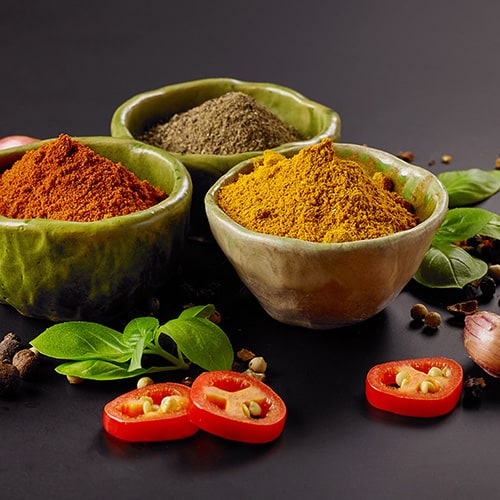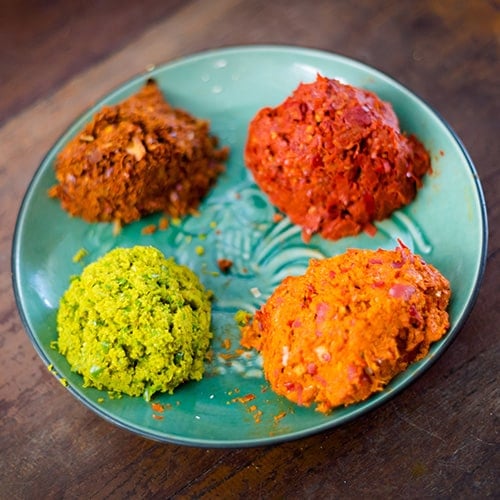When you think of curry, you may envision a saucy stewed dish on an Indian restaurant’s menu, but is India the origin of curry? We research this aromatic food trend to discover what it is, how it’s made, and what curry varieties exist in the food industry.
You may use the following links to navigate through the blog:
- What Is Curry?
- What Is Curry Powder?
- What Is Curry Paste?
- What Are Curry Leaves?
- Thai Curry vs Indian Curry
What Is Curry?
The word curry doesn’t refer to one dish in particular, but it is a general term used for a stewed meat, tofu, or vegetable dish cooked in a spiced gravy or aromatic sauce, then served on a bed of rice with flatbread. Curry flavor profiles can vary greatly depending on the chef and region, and they can range from mild to very spicy.
Types of Curry

When you see curry on a menu, most often you’ll find a more specific name for the dish you are ordering. Here are some popular curry dishes you may encounter:
- Chicken Tikka Masala - marinated chicken with a turmeric, tomato, and yogurt curry sauce over rice (English variation of curry)
- Butter Chicken - chicken with a buttery tomato cream sauce over rice (Indian variation of curry)
- Korma - mildly spiced chicken in a sweet creamy sauce with nuts over rice (Pakistani variation of curry)
- Dhansak - mutton or goat cooked in a lentil and vegetable sauce with a medium heat rating and served over brown rice (Persian variation of curry)
- Vindaloo - spicy pork marinated in a wine and garlic sauce, served with rice (Portuguese variation of curry)
- Panang - pork cooked in a red chili pepper and peanut sauce, reduced in coconut milk, and served over brown rice (Thai variation of curry)
With all of these variations available, you may be asking “so, where does curry come from?” Keep reading to explore the origin of curry.
Curry Origin
Curry dishes originated from Indian cuisine, but the term curry was popularized by the British during their rule of India in the 18th century. The English likely became familiar with the term kari, which means sauce in Tamil (a language spoken in India). Although the term was created in the 18th century, sauce-based dishes are thought to have existed in India as early as 2500 BCE. The popularity of curry dishes spread around the world as the English created spice combinations to mimic the dishes they found in India and shared with other nations through trade routes and the Silk Route.
Curry Nutrition
Because curries recipes vary, their nutritional value will differ from each other. However, most curries share similar exotic spices and blends and many depend heavily on turmeric, coriander, and cumin. These spices have high anti-inflammatory and detoxifying properties. Curries are also great sources of vitamin B6, iron, magnesium, and fiber.
Back to TopWhat Is Curry Powder?

Curry powder is a blend of spices using ingredients typically found in Indian cooking. Curry spice blends were created by the British looking to bring the flavors of Indian cuisine back to England. Curry powders are most commonly used to make Tikka Masala, an English curry, but are generally not used in India. You can also find curry powder in the form of curry roux cubes, which are typically used in Japanese curries like kare raisu.
What Is Curry Powder Made Of?
These are the common spices used in curry powder blends:
- Turmeric
- Coriander
- Cumin
- Ginger
- Cloves
- Black Pepper
- Garlic
- Cinnamon
- Saffron
- Mustard Seed
- Fennel
Variations and nuances may occur depending on where the curry powder is sourced.
Curry Powder Shelf Life
The shelf life of curry powder is 3-4 years when stored in a cool, dark place. Over time, the blend will lose its fragrance and potency. Curry powders found in supermarkets may have been sitting on the shelf for some time and may not be the freshest at time of purchase. You may make your own curry powders by grinding fresh herbs and spices for the richest flavors.
How to Use Curry Powder
When cooking with curry powder, you’ll want to heat the spices first to bring out the rich aromas and flavors before adding your protein.
- Heat oil on a medium heat in a pan.
- Add chopped onion and salt to the heated oil until onions are golden.
- Add ginger, garlic, and chopped tomatoes until the ingredients start to caramelize.
- Add the curry powders into the pan and allow to cook for 2-3 minutes, stir continuously.
- Add your protein and coat it in the curry.
- Saute for 1-2 minutes on a low heat with the lid on.
- Uncover and add water to create the sauce.
- Cover and let the dish simmer for 10 minutes.
- Add cream or yogurt and mix on a low heat (optional).
- Serve over rice.
You can use curry powders to make traditional sauce-filled dishes, but you can also incorporate it into other recipes. Sprinkle curry powder on vegetables, popcorn, or deviled eggs for a flavorful twist. Use curry powder to season warm soups, or create a rich marinade for meats that will have your guests coming back for seconds.
What Is Curry Paste?

Curry paste is a flavorful puree made from spices mashed with chili peppers and galangal (a tropical root plant similar to ginger) that is used as the base ingredient in various curry dishes. Curry paste is usually used in Thai dishes instead of Indian-style dishes. Curry pastes come in various colors depending on the chili pepper used in their preparation, which tends to make them quite spicy. The most common curry pastes that you’ll find in a grocery store are red curry paste, yellow curry paste, and green curry paste.
What Is Curry Paste Made Of?
There can be slight variations to the ingredients used in a curry paste depending on the curry color and brand. Here are the common ingredients found in curry paste:
- Chili peppers (red, yellow, or green)
- Galangal
- Tomato Puree
- Lemongrass
- Ginger
- Turmeric
- Paprika
- Cinnamon
- Coriander
- Cumin
- Vinegar
How to Use Curry Paste
In South Asian cuisine, curry pastes are typically sauteed with oil and thinned using coconut milk.
- Heat oil in a pan on medium heat.
- Season your protein and add it to the oil. Cook for 2-3 minutes until lightly browned.
- Add your curry paste and ginger and allow to cook for 1 minute.
- Add coconut milk, reduce the heat to medium-low.
- Bring the dish to a boil, stirring occasionally for 5-10 minutes or until the broth has reached desired thickness.
- Add desired vegetables, coating them in the sauce, and cook for another 2-3 minutes to allow them to soften.
- Removed from heat and garnish with cilantro and lime.
- Serve over rice.
Along with stews and curries, you can also use curry pastes to make a salad dressing with yogurt or mayonnaise. Use it as a marinade for chicken, beef, and seafood to add a bold flavor to your menu. You can even prepare a vegan Thai curry with plant-based meat alternatives like tofu to accommodate vegans and vegetarians in your restaurant.
Curry Paste vs Curry Powder
The main difference between curry powder and curry paste is that curry powder is a dry ingredient that must have oil and water added to it, whereas curry paste is a wet concentrated ingredient that needs to be diluted in the cooking process. Curry paste uses whole chili peppers, while curry powder usually does not contain any chili, making the heat level in curry paste more intense than that of curry powder. Curry paste is not a substitute for curry powder or vice versa. Curry paste is ideal for Thai-style curries but the flavor profile does not match what is expected of an Indian-style curry.
What Are Curry Leaves?
Curry leaves are glossy green leaves that are typically used in curry dishes in the same way a chef might use bay leaves to add additional aroma and flavor to a dish. They come from curry trees, which are part of the citrus fruit family and feature a strong warming scent. Curry leaves are traditionally fried in oil to release the flavor and added to a curry sauce to simmer with the dish.
Back to TopThai Curry vs Indian Curry
The main difference between Thai curry and Indian curry is that while Indian curries typically use a spice blend that is diluted with water and occasionally yogurt, Thai curries use curry paste that is diluted with coconut milk. Indian curries depend highly on turmeric and coriander, whereas Thai curries depend heavily on chili peppers. Thai curries usually feature more heat and a creamy consistency, while Indian curries are highly savory and more soup-like, closer to the consistency of hot sauce.
Types of Thai Curry

When you see curry colors listed on a menu, you are most likely encountering a version of Thai curries. The following is a list of the most popular types of Thai curry:
- Green Curry
- Red Curry
- Yellow Curry
- Panang
- Masam
- Sour Curry
Below, we identify the difference between the three curry colors:
What Is Green Curry?
Green curry is a spicy stewed dish made by combining green curry paste with a protein or vegetable, and it is considered to be the most popular variation of Thai curry. Green curry is also the hottest of the curry colors. Green curry paste (kreung gaeng keo wahn) gets its vibrant green color from fresh green chili peppers, fresh cilantro, makrut lime leaves and peels, and basil. It usually also features lemon grass, shrimp paste, garlic, and peppercorn among its ingredients. It is typically served with beef or chicken.
What Is Red Curry?
Red curry is a medium sauce-based dish made by combining red curry paste with a protein or vegetable and it is considered to be one of the most versatile of the Thai curries. Red curry features a medium heat level, which can be boosted with chilies or mellowed with tomato paste. Red curry paste (kreung gaeng phet daeng) gets its bold red color from dried long red chili peppers, shrimp paste, and fresh turmeric. Among its ingredients list, you’ll also find cilantro root, coriander, cumin, lemon grass, and galangal. It is generally served with chicken, duck, or shrimp.
Red Curry vs Green Curry
Red curry is made from dried long red chilies and is milder in heat compared to green curry, which is made from green chilies and tends to be the hottest of the Thai curries. Green curry is the most popular in Thailand, while red curry paste is used in a greater variety of dishes.
What Is Yellow Curry?
Yellow curry is a mellow Thai stewed dish made from yellow curry paste that most closely resembles an Indian-style curry. Because of its resemblance to the Indian dish and its mild heat rating, yellow curry is a dish most commonly found on international restaurant menus. Yellow curry paste (nam prik gaeng karee) features a sweet flavor and soothing pale yellow color that comes from turmeric and yellow chili peppers. Other ingredients include coriander seed, lemongrass, galangal, ginger, cumin, and shallots. It is normally served with chicken or fish.
Back to TopIncrease your restaurant’s spice library by adding some curry options to your menu. Your customers will appreciate the warming flavors provided by these cultural dishes regardless of which recipe and style you choose.



